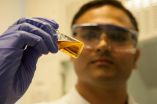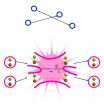(Press-News.org) PITTSBURGH, July 22, 2015 - Late- and post-menopausal women have significantly greater volumes of fat around their hearts - a risk factor for heart disease - than their pre-menopausal counterparts, a University of Pittsburgh Graduate School of Public Health study has shown for the first time.
The finding, published online and scheduled for the Sept. 1 issue of The Journal of Clinical Endocrinology & Metabolism, likely can be attributed to changing hormone levels and could guide potentially life-saving interventions. The work was funded by the National Institutes of Health (NIH) and American Heart Association (AHA).
"Cardiovascular disease is the leading cause of death in women, and it increases after age 50 - the average age when a woman is going through menopause," said lead author Samar R. El Khoudary, Ph.D., M.P.H., assistant professor in Pitt Public Health's Department of Epidemiology. "By showing that menopause appears to be associated with a shift in fat deposits that leads to more fat around the heart, we've uncovered a new potential contributor to increased risk of cardiovascular disease in women."
Weight gain in women during and after menopause has long been attributed to aging, rather than menopause itself. However, recent research identified changes in body fat composition and distribution due to menopause-related hormonal fluctuations.
No previous study had evaluated whether those changes in fat distribution during menopause affect cardiovascular fat. Increased and excess fat around the heart and vasculature can be more detrimental than abdominal fat, causing local inflammation and leading to heart disease. Doubling certain types of cardiovascular fat can lead to a more than 50 percent increase in coronary events.
Dr. El Khoudary and her team evaluated clinical data, including blood samples and heart CT scans, on 456 women from Pittsburgh and Chicago enrolled in the Study of Women's Health Across the Nation (SWAN). The women averaged about 51 years of age and were not on hormone replacement therapy.
As concentrations of the sex hormone estradiol - the most potent estrogen - declined during menopause, greater volumes of cardiovascular fat were found. The finding held even after the team took into account the effects of age, race, obesity, physical activity, smoking, alcohol consumption, medication use and chronic diseases.
"Developing prevention strategies to reduce cardiovascular fat in women at midlife may reduce their heart disease risk, especially knowing that the menopausal transition puts women at risk for excess fat around their hearts," said Dr. El Khoudary. "Previous studies suggest that reducing heart fat is feasible through weight loss or weight management, but these studies only looked at small numbers of people and there have been no clinical trials linking cardiovascular outcomes with heart fat changes due to weight management interventions. Clearly there is a need for larger scale studies to determine the best intervention strategies to help post-menopausal women reduce fat near the heart."
Dr. El Khoudary and her research team are working on seeking more funds to evaluate whether cardiovascular fat volumes progress over time in midlife women, and, if so, whether this progression will be associated with greater evolution in atherosclerosis and more cardiovascular events in post-menopausal women.
INFORMATION:
Additional authors on this study are senior author Karen A. Matthews, Ph.D., of Pitt; and co-authors Kelly J. Shields, Ph.D., of Allegheny Health Network; Imke Janssen, Ph.D., and Lynda H. Powell, Ph.D., both of Rush University Medical Center; Carrie Hanely and Emma Barinas-Mitchell, Ph.D., both of Pitt; Matthew Budoff, M.D., of the Los Angeles Biomedical Research Institute; and Susan A. Everson-Rose, Ph.D., of the University of Minnesota Medical School.
This research was supported by NIH grants U01NR004061, U01AG012505, U01AG012535, U01AG012531, U01AG012539, U01AG012546, U01AG012553, U01AG012554 and HL065591; and AHA grant 12CRP11900031.
Electronic cigarettes or "e-cigs" have been touted as a tool smokers can use to wean themselves off of traditional cigarettes, which many believe are more harmful than their "e" counterparts. But because e-cig liquid also contains nicotine and emits carcinogens, is that perception really true? One team now reports in the ACS journal Chemical Research in Toxicology that much of the nicotine in e-cigarettes is the addictive form of the compound.
Although e-cigs don't burn tobacco, they heat and vaporize a liquid that contains nicotine, flavorings and other substances. ...
Stem cells hold great potential for addressing a variety of conditions from spinal cord injuries to cancer, but they can be difficult to control. Scientists are now reporting in the journal ACS Nano a new way to mimic the body's natural approach to programming these cells. Using this method, they successfully directed adult stem cells to turn specifically into muscle, which could potentially help treat patients with muscular dystrophy.
In the 1990s, scientists first isolated human embryonic stem cells, which can turn into any kind of cell in the body, and the promise ...
A guideline--recommendations on diagnosing and treating a particular disorder--aims to present the best possible treatment for patients. However, when guidelines are compiled their authors often have conflicts of interest, for example as a result of funding or membership in specialist societies that are in close contact with industry. In a recent original article in Deutsches Ärzteblatt International (Dtsch Arztebl Int 2015; 112: 445-51), Gisela Schott et al. determine that most guideline authors do declare their conflicts of interest. However, this rarely has consequences ...
Automakers are looking for ways to improve their fleets' average fuel efficiency, and scientists may have a new way to help them. In a report in the journal ACS Applied Materials & Interfaces, one team reports the development of a material that could convert engine heat that's otherwise wasted into electrical energy to help keep a car running -- and reduce the need for fuels. It could also have applications in aerospace, manufacturing and other sectors.
In 2012, the Obama administration announced fuel-efficiency standards that would require U.S. vehicles to average 54.5 ...
Lithium-ion batteries remain the technology-of-choice for today's crop of electric cars, but challengers are revving up to try to upset the current order. An article in Chemical & Engineering News (C&EN), the weekly newsmagazine of the American Chemical Society, takes a look at two of the top contenders vying to erode lithium-ion's dominance.
Alex Scott, a senior editor at C&EN, reports on two developments from companies in England that seem poised to compete in the electric car battery market within the next two to four years. One is a sodium-ion version, produced by ...
If you experience a major heart attack the damage could cost you around five billion heart cells. Future stem cell treatments will require this number and more to ensure those cells are replaced and improve your chances of survival.
Experts at The University of Nottingham have discovered the first fully synthetic substrate with potential to grow billions of stem cells. The research, published in the academic journal Advanced Materials, could forge the way for the creation of 'stem cell factories' - the mass production of human embryonic (pluripotent) stem cells.
The ...
Canada has almost eliminated mother-to-child HIV transmission, known as vertical transmission, in recent years by ensuring that all women have the opportunity to be screened for HIV in pregnancy and that women with the disease receive treatment before giving birth.
In 2014, there was only one recorded transmission of the virus to babies born to women known to be living with HIV.
These findings were presented at the International AIDS Society 2015 conference in Vancouver by researchers from the Canadian Perinatal HIV Surveillance Program (CPHSP), a national group that ...
SALT LAKE CITY- As part of a multi-institutional effort, researchers with Huntsman Cancer Institute at the University of Utah have found that multiple myeloma patients with a genetic variation in the gene FOPNL die on average 1-3 years sooner than patients without it. The finding was identified with a genetic mapping technique, genome wide association studies (GWAS), and verified in patient populations from North America and Europe. This was the first study to survey the entire human genome for genetic variation influencing survival, and included a total of 1,635 patients.
Published ...
A test of the Mobile Bridge® Version 4.0 (MB4.0) over a real river demonstrated its viability for practical use. During the test, the bridge was set up without any foundation work, and a vehicle could easily travel across it. This was achieved safely with very few people and without any problems. The MB4.0 viability test results were presented at a symposium of the Japan Society of Civil Engineers (JSCE) on June 23, 2015, by Dr. Ichiro Ario, Assistant Professor at the Institute of Engineering, Hiroshima University.
Background of developing MB:
Natural disasters include ...
A new theory says dark matter acts remarkably similar to subatomic particles known to science since the 1930s.
We owe a lot to dark matter - it is the thing keeping galaxies, stars, our solar system, and our bodies intact. Yet no one has been able to observe it, and it has often been regarded as a totally new exotic form of matter, such as a particle moving in extra dimensions of space or its quantum version, super-symmetry.
Now an international group of researchers has proposed a theory that dark matter is very similar to pions, which are responsible for binding atomic ...


